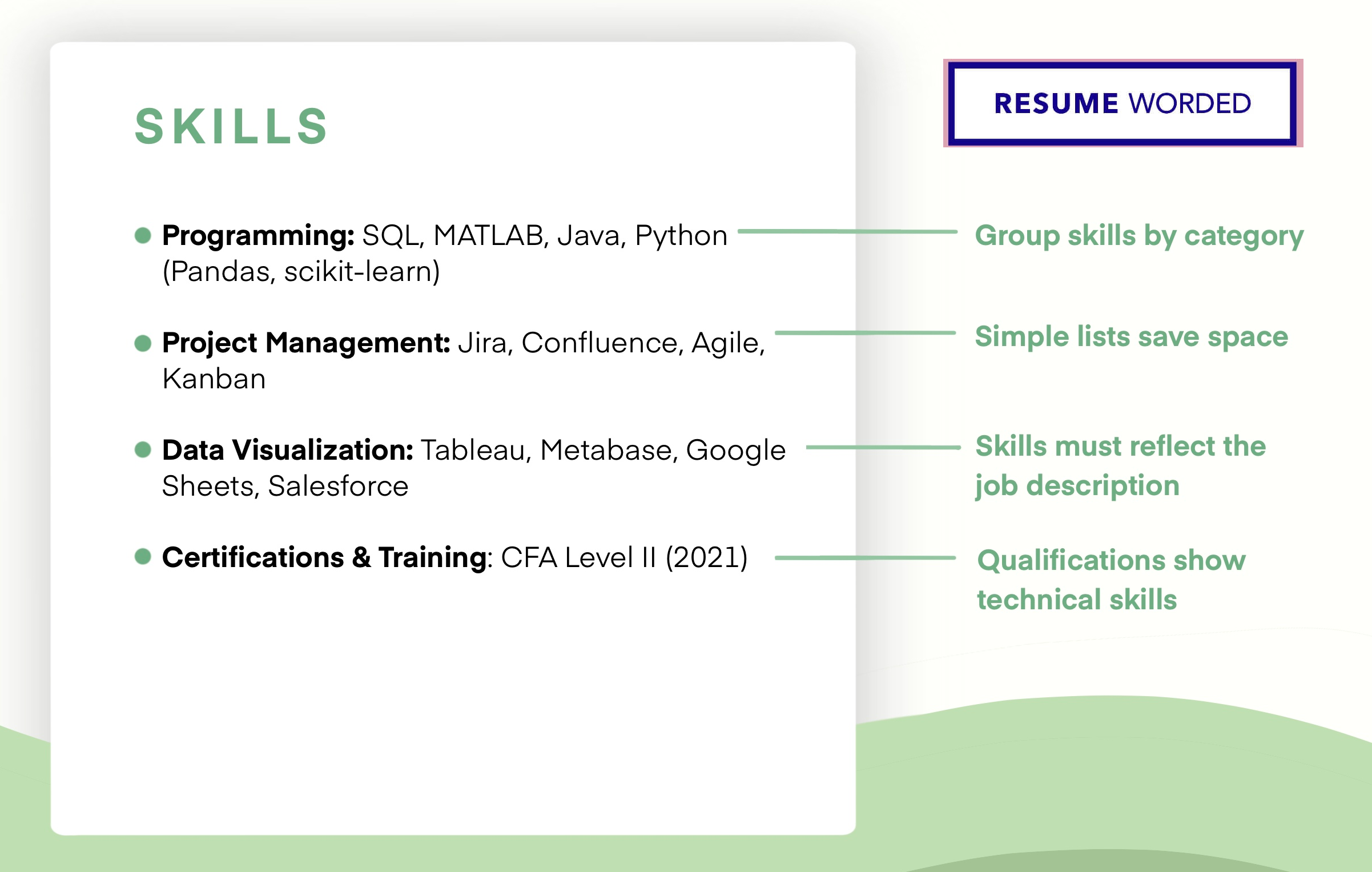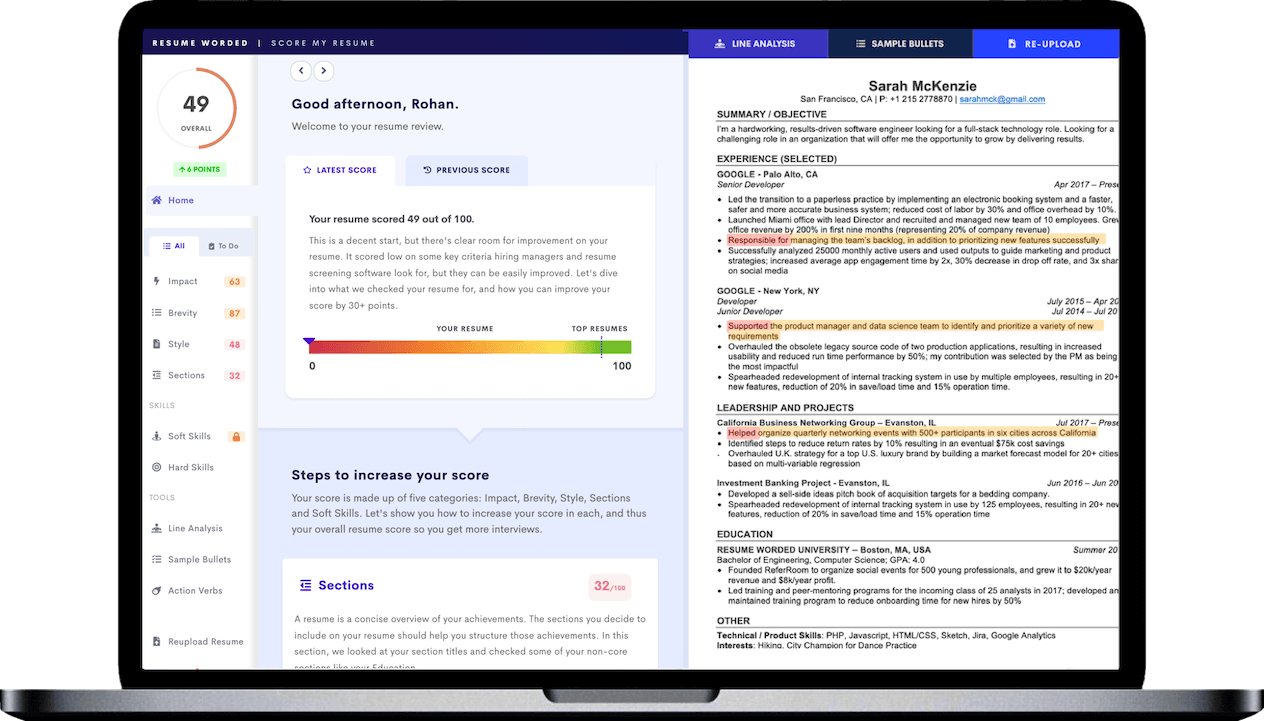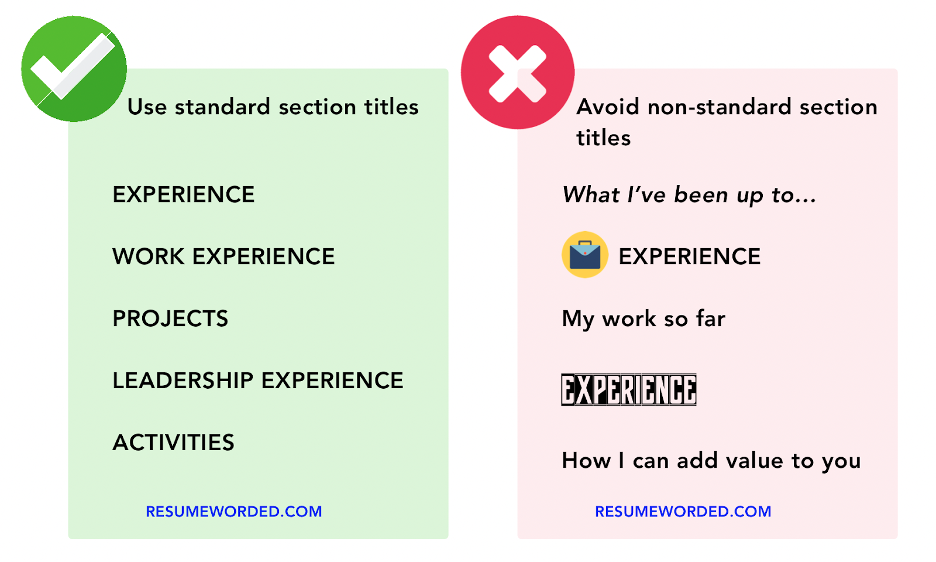Do hiring managers really toss resumes over one tiny mistake? Some don't, but others do — and with good reason. At the early stages of a job application, your resume is the only thing a recruiter knows about you, which means that even the smallest detail can be a big deal.
What is a resume red flag? Anything that raises doubts about your professionalism, integrity, or attention to detail. Any of these can be an immediate dealbreaker — regardless of how perfect your skills, experience, or qualifications may be otherwise.
Before you let hours (or even days or weeks) of effort go to waste over a simple mistake, scroll through our top 10 tips for how to overcome red flags on your resume.
10 Red Flags on a Resume
According to recruiters, here are the 10 most common red flags on a resume that could lead to you missing out on a job:
- Small but obvious mistakes like typos and SPAG errors
- Poor formatting
- Too much (or too little) personal information
- Unprofessional social media presence
- Outdated skills
- Employment gaps
- Job hopping
- Multiple career changes
- Lack of career progression
- Generic "one size fits all" resumes
Some of these are obviously fairly superficial, while others are more substantive. But they all have one thing in common: Any one of them could jeopardize your job prospects.
Let's take a deeper look at what constitutes a resume red flag — and how to fix it.
Red flag #1: Obvious mistakes
Spelling and grammatical mistakes, missing words, incorrect dates or business names, obvious cut and paste errors, and placeholder text all signal one thing: Lack of attention to detail.
Why it’s a red flag: The first thing hiring managers want to see is that you actually care about getting the job. Even small mistakes can send a message that you couldn’t be bothered to proofread your resume — even if you did.
How serious it is: Not that serious, but heavily dependent on the specific hiring manager. Don't take the chance that the person reading your resume is a stickler for spelling and grammar.
How to fix it: Don’t just rely on the automated spellcheck function — Word, Google Docs, and even Grammarly can all miss obvious mistakes. Try:
- Reading your resume out loud
- Reading your resume backward or section by section
- Uploading your resume to a free resume checker
- Asking a friend or family member to double check for mistakes
Red flag #2: Poor formatting
It’s not just a matter of aesthetics — poorly formatted resumes are harder to read, impossible to skim, and make it difficult for recruiters to notice key information. Bad formatting may even cause issues with Applicant Tracking Systems (ATS), which can lead to your resume getting rejected even if you’re a good fit.
Why it’s a red flag: Like obvious mistakes, poor formatting on your resume signals that you didn't put a lot of time or effort in, which is likely to make a potential employer wonder if you'll put in just as little effort once you get the job.
How serious it is: This also depends on the preferences of the specific recruiter, and to some extent on your industry — applying to a design job with a poorly formatted resume is likely to be a bigger deal than it would be for an engineering role.
How to fix it: Start with a pre-formatted — and ATS-friendly — resume template. Once you're done, run your resume through our Score My Resume tool to pick up any formatting issues that may be messing with ATS.
Red flag #3: Too much (or too little) information
More isn't always better, especially when it comes to resumes. Including the wrong information signals that you're out of touch with professional norms, which isn't the first impression you're trying to make.
Why it’s a red flag: Including too many personal details looks unprofessional and — in the worst case scenario — can put you at risk of discrimination. On the other hand, not including essential information (like your contact details) looks like carelessness and makes it more difficult for recruiters to contact you.
How serious it is: Minor and easily fixable. Recruiters aren't likely to toss your resume just because you included your full street address, but they will be on the lookout for other indicators of professionalism (or a lack thereof).
How to fix it: Make sure your resume header and contact information contain the standard details — no more and no less.
Always include your:
- Name
- Phone number
- Email address
- Location
Never include your:
- Age
- Race
- Gender
- Sexual orientation
- Marital status
- Political affiliation
Red flag #4: Unprofessional social media presence
In 2025, you’d better believe that the majority of employers will do a social media check as part of their vetting process. While having no social media presence isn’t likely to be a red flag (except in certain industries, like online marketing), showing poor judgment on social media definitely is.
This even extends to your email address. You don't need to have your own professional email domain, but at the same time, try to avoid email hiring managers from "[email protected]."
Why it’s a red flag: Like it or not, what you do online can reflect on your employer. It also signals what kind of employee you're likely to be, so if your social media is full of controversial political, social, or religious opinions, it may alienate employers who aren't looking for drama.
How serious it is: Depending on what's on your social media, it can be a very big deal. A couple of revealing shots on your Instagram or a Yahoo or Hotmail email address? Not likely to be a big problem. A very public political argument complete with name calling? Much worse.
How to fix it: You don't need to completely change the way you use social media — just make sure your bikini shots aren't the first thing an employer sees when they google your name. Here are some tips:
- Maintain an active LinkedIn profile so it’s the first thing recruiters see when they search for you online.
- If you have personal social media accounts, keep them employer-friendly (or lock them down completely).
- If you don't already have a reasonably professional or neutral email address, sign up for any standard email provider (Gmail is usually the best option).
- Try for any combination of your first, last, and middle names — play around with it until you find one that isn’t taken.
Red flag #5: Outdated skills
Your resume skills section should list 5-10 relevant hard skills so that recruiters can see at a glance if you have the skills they're looking for. Too many skills, poor organization, or outdated entries can all work against you.
Why it’s a red flag: Listing common skills like “email” or “Microsoft Word” implies one of two things — that you don’t have any better skills to list, or that you don’t realize those skills have become standard in 2025. The first means that you’re probably not a great fit, while the second risks age-related discrimination.
How serious it is: This is another thing that probably won't get your resume thrown out all on its own, but it also isn't doing you any favors. At the very least, it means the rest of your resume or application will have to work a lot harder to make up for it.
How to fix it: Scan the job description for must-have skills and use our hard skills and keywords finder for a list of common (and up to date) skills by industry or job title, or check out the tool below.
Red flag #6: Employment gaps
In 2025, why do employers still care about resume gaps? The truth is, some don’t — and that number is only getting larger — but many still do, especially in more old-fashioned or conservative industries.
Why it’s a red flag: A long employment gap on your resume can indicate something worse — like that you were fired or quit without warning, or that other employers are seeing something about you that's unemployable.
How serious it is: Not likely to be a major problem as long as you have a good reason for any longer gaps (6 months or more).
How to fix it: Address any resume gaps simply and directly. If you left a job after a short time for a good reason — for example, if it was always intended as a short-term contract — it’s also okay to indicate that on your resume.
Red flag #7: Job hopping
Short stays and unexpected departures will almost always raise a red flag on your resume. Companies want employees who are in it for the long haul, which means that your resume shouldn't scream "I'm probably going to leave as soon as my training is finished."
Why it’s a red flag: A history of job hopping or pattern of short stays on your resume after only a short time can sometimes indicate that you were fired, left on bad terms, or are likely to leave this job early or without warning.
How serious it is: In 2025, job hopping still a big deal to some employers, but it's also becoming a lot more common. One or two short stays on your resume is totally fine, but if you have a larger pattern of job hopping, hiring managers are going to wonder what's up.
How to fix it: Apart from resolving to stay at your next job for at least 2-3 years, there's not much you can do to fix the past — but there are ways to obscure it a little. You can:
- Consolidate similar short-term jobs under one heading, like "Professional Wait Staff."
- List freelance or contract work under a single employer — this could be a temp agency or your own consulting company.
- Leave off very short-term jobs — you're not likely to have any resume-worthy accomplishments if you were only there for a couple of months.
Red flag #8: Multiple career changes
Changing careers is more common in 2025 than it was even five or ten years ago — but that doesn’t mean everyone understands it.
Why it’s a red flag: If your overall career trajectory is hard to follow or you’ve bounced around to multiple unrelated jobs or industries without a clear goal, recruiters may wonder if you’ll be unable to commit to this one, too.
How serious it is: This is another thing that's becoming more and more common. A career change isn't a red flag on its own, but it can become one if you don't explain why you're applying for the job you've chosen.
How to fix it: If you’re changing careers, address your reasoning upfront with a brief resume summary. If you’re worried about not having the right background, focus on relevant accomplishments and transferable skills instead.
Red flag #9: Lack of career progression
While you may just be happy in your current role, most recruiters see flat career progression as a lack of ambition — or as a sign that you’ve been knocked back from positions with more responsibility.
Why it’s a red flag: Hiring managers want to see motivation, drive, and a willingness to learn new things. A lack of career progression signals the opposite of this, which means more recruiters are going to wonder if your career has stagnated by choice or if your work just isn't good enough to allow you to progress further.
How serious it is: Fairly serious. Companies don't want to hire people who are happy to settle for "good enough" — they want employees who are willing to put in 110% (whether that's a reasonable expectation or not).
How to fix it: If you’ve ever been promoted, highlight that on your resume. If not, include examples of accomplishments where you’ve taken on additional responsibilities, learned something new, or otherwise stepped out of your comfort zone.
Red flag #10: Generic resumes
Your resume should tell a story about why you’re a good fit for the job you’re applying for. What it shouldn’t do is look like you’ve sent the exact same document to every single job you’ve ever applied for.
Why it’s a red flag: A generic resume implies either a lack of suitability or a lack of effort — either of which can cost you the job.
How serious it is: Very. If your resume doesn't say anything about why you're a good fit for this specific job, why would a recruiter want to hire you?
How to fix it: Tailor your resume to the specific job you’re applying for by:
- Emphasizing the most essential parts of your background, qualifications, and experience.
- Leaving out any information that isn’t relevant — including past jobs.
- Using our Targeted Resume tool to check your resume against the job description and get feedback on how to make your resume an even better match.










